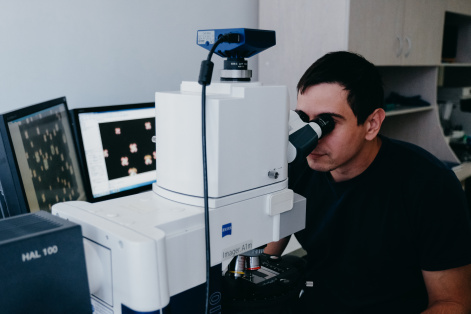Scientists from Krasnoyarsk and Moscow have created a new structure in LCD technology
24 September 2021 г.

The substances used by scientists, namely cholesterics, do not have any central symmetry, unlike ordinary liquid crystals (nematics). As the scientists say, they form a special volumetric structure, reminiscent of a cube, spirally twisted along one of the sides.
According to scientists, cholesterics are much more complex than the usual liquid crystals used in modern electronics. Their key property, which is in demand in the production of equipment, is the ability to change the pitch of the spiral or its orientation in space under a certain influence from the outside. This allows cholesterics, for example, to change their color, like the skin of a chameleon.
Scientists created a new type of cholesteric structure with a unique response to an electric field. They succeeded in "assembling" individual molecules into a large periodic structure in a special way, making it possible to control the properties of the material in a new way.
"Today, liquid crystal systems of two geometry types are used: tangential, where the LC molecules lie parallel to the interface between the materials, and homeotropic, in which the molecules lie perpendicular to the interface. In our cholesteric, the molecules are tilted at an angle of 50 degrees to the interface. It turned out that this creates an extremely interesting periodic microstructure, which, for example, will allow using cholesteric as an instantly tunable diffraction grating, "says Mikhail Krakhalev, senior researcher at the L. V. Kirensky Institute of Physics SB RAS, associate professor of the Department of General Physics at the Siberian Federal University.
The results obtained, according to the authors, will help in the development of new devices with non-mechanical control of the light beam; these are projection displays (for example, for augmented reality glasses), compact spectrometers and lasers with variable structure and properties.
"We obtained samples with a large one-dimensional periodic structure and showed that the electric field can effectively control its orientation. The material with such properties will help to develop diffraction gratings in which not only the intensity of diffraction maxima is controlled, but also the orientation of the plane in which the light diffracts," - says Mikhail Krakhalev.
Any liquid crystal is sensitive to the electric field and influence of the surfaces with which they are in contact. According to the scientists, the periodic structure they obtained demonstrates different types of response to the electric field, depending on the magnitude of the applied voltage.
At a relatively high electrical voltage (about 7 volts), the periodic structure transforms into the homogeneous nematic state. If the voltage is then reduced to 1.1 Volts or lower, the structure of the cholesteric will "reappear". The orientation of this new structure will again depend on the magnitude of the growth stress. In the future, the research team plans to increase the rotation angle of the periodic structure and reduce its response time.
Source: Siberian Federal University
Share:
